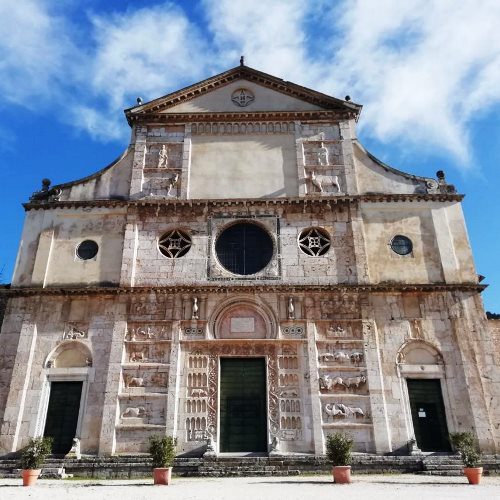Benché le origini della Basilica di San Pietro si facciano risalire già al V secolo l’attuale aspetto dell’edificio è sicuramente il frutto degli interventi del XII secolo sulla facciata e del XVIII secolo nell’interno. Particolarmente notevoli i tre portali e i bassorilievi romanici che fiancheggiano il portale mediano.
La decorazione della facciata, che senza dubbio è l’elemento più interessante dell’ edificio, rappresenta in alto i SS. Pietro e Andrea e due tori, simboli del sacrificio, al centro tre rosoni di cui quello centrale conserva i quattro simboli degli evangelisti l’aquila per S. Giovanni, l’angelo per S. Matteo, il toro per S. Luca e il leone per S.Marco, in basso infine dieci storie tratte dal nuovo testamento e da favole e bestiari medioevali: morte del giusto, morte del peccatore, il leone e il boscaiolo, il leone e l’uomo genuflesso, il leone assale il soldato, la lavanda dei piedi, vocazione dei SS. Pietro e Andrea, la volpe finta morta e i corvi, il lupo studente e il montone, il leone combatte contro il dragone.
Although the origins of the Basilica of St. Peter go back to the 5th century, the present appearance of the building is definitely the result of interventions during the 12th century on the facade and during the 18th century in the interior. Particularly impressive are the three portals and the romanic bas-reliefs which flank the middle portal.
The decoration of the facade, which is without doubt the building’s most interesting element, represents in the uppermost part St. Peter and St. Andrew and two steers, symbols of sacrifice; at the center three rose wondows of which the central one contains the symbols of the Evangelist: the eagle for St. John, the angel for St. Matthew, the steer for St. Lucas and the lion for St. Mark; in the lower part, finally, ten scenes taken from the New Testament and from fairy-tales and medieval bestiaries: death of the just man; death of the sinne;, the lion and the woodcutter; the lion and the man genuflecting; the lion attacking the soldier; the washing of the feet; the vocation of St. Peter and St. Andrea; the fox pretending to be dead and the crows; the wolf and the ram; the lion battling against the dragon.
Although the origins of the Basilica of St. Peter go back to the 5th century, the present appearance of the building is definitely the result of interventions during the 12th century on the facade and during the 18th century in the interior. Particularly impressive are the three portals and the romanic bas-reliefs which flank the middle portal.
The decoration of the facade, which is without doubt the building’s most interesting element, represents in the uppermost part St. Peter and St. Andrew and two steers, symbols of sacrifice; at the center three rose wondows of which the central one contains the symbols of the Evangelist: the eagle for St. John, the angel for St. Matthew, the steer for St. Lucas and the lion for St. Mark; in the lower part, finally, ten scenes taken from the New Testament and from fairy-tales and medieval bestiaries: death of the just man; death of the sinne;, the lion and the woodcutter; the lion and the man genuflecting; the lion attacking the soldier; the washing of the feet; the vocation of St. Peter and St. Andrea; the fox pretending to be dead and the crows; the wolf and the ram; the lion battling against the dragon.
Although the origins of the Basilica of St. Peter go back to the 5th century, the present appearance of the building is definitely the result of interventions during the 12th century on the facade and during the 18th century in the interior. Particularly impressive are the three portals and the romanic bas-reliefs which flank the middle portal.
The decoration of the facade, which is without doubt the building’s most interesting element, represents in the uppermost part St. Peter and St. Andrew and two steers, symbols of sacrifice; at the center three rose wondows of which the central one contains the symbols of the Evangelist: the eagle for St. John, the angel for St. Matthew, the steer for St. Lucas and the lion for St. Mark; in the lower part, finally, ten scenes taken from the New Testament and from fairy-tales and medieval bestiaries: death of the just man; death of the sinne;, the lion and the woodcutter; the lion and the man genuflecting; the lion attacking the soldier; the washing of the feet; the vocation of St. Peter and St. Andrea; the fox pretending to be dead and the crows; the wolf and the ram; the lion battling against the dragon.
Although the origins of the Basilica of St. Peter go back to the 5th century, the present appearance of the building is definitely the result of interventions during the 12th century on the facade and during the 18th century in the interior. Particularly impressive are the three portals and the romanic bas-reliefs which flank the middle portal.
The decoration of the facade, which is without doubt the building’s most interesting element, represents in the uppermost part St. Peter and St. Andrew and two steers, symbols of sacrifice; at the center three rose wondows of which the central one contains the symbols of the Evangelist: the eagle for St. John, the angel for St. Matthew, the steer for St. Lucas and the lion for St. Mark; in the lower part, finally, ten scenes taken from the New Testament and from fairy-tales and medieval bestiaries: death of the just man; death of the sinne;, the lion and the woodcutter; the lion and the man genuflecting; the lion attacking the soldier; the washing of the feet; the vocation of St. Peter and St. Andrea; the fox pretending to be dead and the crows; the wolf and the ram; the lion battling against the dragon.


Comment (0)